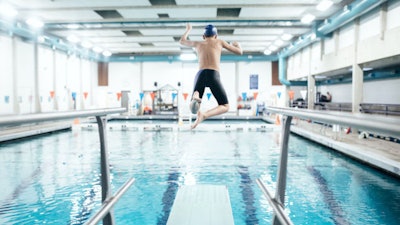
This content was provided by Pentair. What is sponsored content?
As commercial aquatic facilities begin to slowly reopen and try to re-attract and welcome patrons, many aquatic facility managers are looking for solutions that will help improve both the water and air quality of their facilities. One of the most effective ways to quickly do this is to add an ultraviolet (UV) system to the equipment room. Not only do UV systems help improve both the air and water quality of indoor swimming pools, they also reduce chemical usage, which helps commercial aquatic facilities save money.
Indoor aquatic facilities often suffer from poor air and water quality, especially with high bather loads. Recommendations from the Model Aquatic Health Code (MAHC) suggest the use of a secondary sanitation system in these cases. One of the most common forms of secondary sanitation in aquatic facilities is a UV system, which uses light to destroy microorganisms.
Upgrading a commercial aquatic facility with medium- and low-pressure UV systems will not only help eliminate chloramines but will also provide the facility with a secondary sanitation system that delivers clearer water and reduces the chlorine required to keep the water sanitized.
Benefits of UV
There are many benefits associated with the installation of a UV system, not only to the aquatic facility and bathers, but also to pool professionals.
Ease of installation and service
One of the often-missed benefits is the ease of UV system installation. UV systems can be easily added onto the pool’s existing circulation system after the filter and before other accessories, such as heaters or chlorinators.
Units come with tailpieces that plumb into the pipes, completing the circulation system with the UV sanitizer by using a few elbows and valves to bypass the unit. This is helpful because it makes winterizing, servicing and maintenance easier by separating the UV unit as needed. Minimal maintenance is required and may include periodic cleaning of the quartz tube inside the UV unit and replacement of the UV lamp when it reaches the end of its life. This procedure typically takes five to 10 minutes to complete and can be easily accomplished using a screwdriver and crescent wrench.
Improved water/air quality and reduced chemical usage
UV secondary disinfection systems like Pentair’s NSF-certified BioShield® Commercial UV disinfection systems provide an alternative to many of the chemicals normally purchased to help with cleaner, clearer swimming pool water. UV also helps provide instant protection against waterborne, chlorine-resistant microorganisms. In addition, ultraviolet light reduces the combined chloramine levels that typically cause poor air quality in aquatic facilities and lead to red eyes, dry skin and other unpleasant side effects for bathers.
Aquatic facilities can even promote the addition of the UV unit to their patrons as a way to re-attract swimmers, promoting the sanitation benefits as well as the air- and water-quality benefits. Offering UV could be a win-win for aquatic facilities as they reopen for business as well as to service professionals who sell and install the units.
Add the Pentair BioShield Commercial low-pressure UV system to your aquatic facility today for a proven solution to improve the water and air quality for staff and guests. Call 800-831-7133 or visit Pentair.com/commercialbioshield for more details.




































